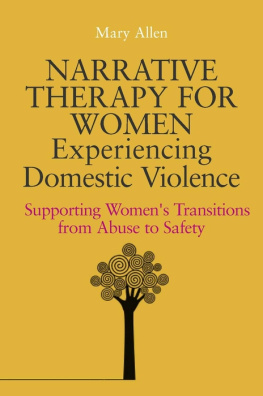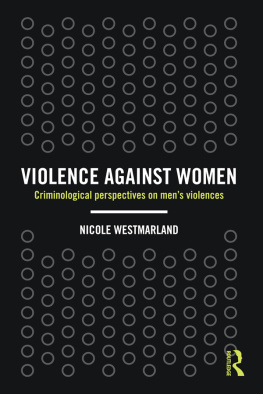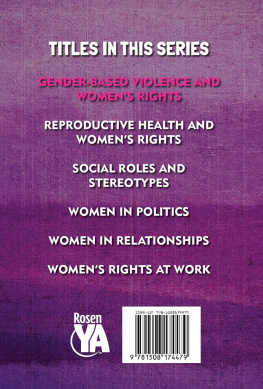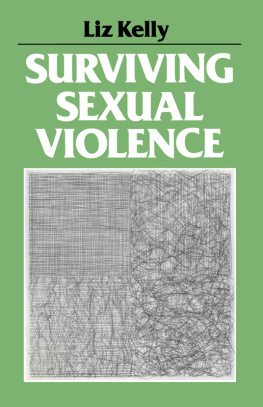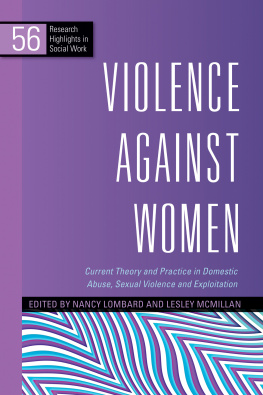Disabled Women and Domestic Violence
Responding to the Experiences of Survivors
Ravi K. Thiara, Gill Hague, Ruth Bashall, Brenda Ellis and Audrey Mullender
Foreword by Nicola Harwin CBE
Jessica Kingsley Publishers
London and Philadelphia
First published in 2012
by Jessica Kingsley Publishers
116 Pentonville Road
London N1 9JB, UK
and
400 Market Street, Suite 400
Philadelphia, PA 19106, USA
www.jkp.com
Copyright Ravi K. Thiara, Gill Hague, Ruth Bashall, Brenda Ellis and Audrey Mullender 2012
Foreword copyright Nicola Harwin 2012
All rights reserved. No part of this publication may be reproduced in any material form (including photocopying or storing it in any medium by electronic means and whether or not transiently or incidentally to some other use of this publication) without the written permission of the copyright owner except in accordance with the provisions of the Copyright, Designs and Patents Act 1988 or under the terms of a licence issued by the Copyright Licensing Agency Ltd, Saffron House, 610 Kirby Street, London EC1N 8TS. Applications for the copyright owners written permission to reproduce any part of this publication should be addressed to the publisher.
Warning: The doing of an unauthorised act in relation to a copyright work may result in both a civil claim for damages and criminal prosecution.
Library of Congress Cataloging in Publication Data
A CIP catalog record for this book is available from the Library of Congress
British Library Cataloguing in Publication Data
A CIP catalogue record for this book is available from the British Library
ISBN 978 1 84905 008 1
eISBN 978 0 85700 558 8
Converted to eBook by EasyEPUB
To all disabled women who are survivors of domestic violence, for their courage and determination, and to disabled women across the world who are working together against violence.
To Simon for all his love and support.
(Audrey Mullender)
To Vijayatara (Dr Sharon Smith) who taught me that violence does not have to control our lives and wise women can laugh.
(Ruth Bashall)
Foreword
Since the early 1970s, feminist activists and survivors of sexual and domestic violence, working together, have helped pioneer significant changes in the way that violence against women and children is understood and responded to within public policy, and we have seen the development of a network of specialist services across the UK.
From the beginning, a commitment to equality and human rights has been the cornerstone of our analysis of gender abuse and of the requirements for service delivery. Yet, despite our best intentions and undoubted improvements in accessibility of services, the voices and needs of disabled women experiencing domestic or sexual abuse have received little real attention in strategic developments on violence against women at either local or national level. Equally, the need to address gender-based violence has not been a priority for most mainstream disability organisations, despite the strenuous efforts of some committed disabled women activists.
This book is itself an example of that uphill struggle: it took nearly a decade to achieve the funding to undertake the research upon which this book is based, despite numerous attempts by disabled women researchers. This book also, therefore, represents a triumph of their commitment and perseverance.
Womens Aid was proud to have had the opportunity to partner with members of the research team and the Advisory Group, supported by funding from the Big Lottery. The findings of the research and the contents of this book set out clearly the tasks and priorities ahead. Disabled women face multiple challenges and discrimination, both in their experiences of domestic and sexual violence, and in gaining access to appropriate services. The common experiences of all victims of domestic and sexual abuse (such as not being believed or being unable to get effective help and support) are compounded by unhelpful stereotypes about disabled women, and their impairments are used by abusers to increase the abusers power and disabled womens vulnerability and isolation.
I hope this book will be a wake-up call for professionals and activists in all relevant statutory and voluntary agencies to review our own policy approaches and ensure that in all our local consultations and strategic planning, the findings and messages in this book, and the voices of disabled women survivors, are heard.
Nicola Harwin CBE
Chief Executive, Womens Aid
Acknowledgements
We are very grateful to Womens Aid for initiating and managing the research on which this book is based, and to the Big Lottery who funded the study. Especial thanks to current and former Womens Aid staff, Nicola Harwin, Nikki Norman, Jackie Barron and Emma Williamson, for all their input.
Our sincerest thanks to the Advisory Group and disabled women consultants who advised the research, for their time, advice and guidance, especially Anne Pridmore, then Chair of the UK Disabled People Council, Jenny Morris and Jane Bethall. We are also particularly grateful for the help of many agencies, professionals and activists in the disability and the domestic violence fields for taking the time to speak to us, respond to surveys, and for giving us valuable contacts. A special thank you for their particular contributions to Jacky Gruhn, Cassie Hague, Dave Merrick and Mel Turner.
Most of all, our heartfelt thanks to all the disabled women domestic violence survivors who participated in the national research as advisers, in focus groups, in workshops and in interviews. Their generosity in being part of this project and their moving experiences are key to this book. We hope that their advice and recommendations for improvements in services for abused disabled women will be realised.
Chapter 1
Introduction
Domestic violence in intimate relationships blights societies, and the lives of individuals, across the world. It pervades all known communities. Look up and down the road or street where you live, for example. You may not realise it is there, but it is. Where domestic abuse is happening, it is likely to be behind the doors and windows, in bedrooms and sitting rooms and kitchens, but it is also there on the street or in places where couples, and adult men and women, meet socially (see Hague and Malos 2005). On the positive side, since the early 1980s, support services for women and children facing domestic violence (and more limited projects for men) have begun to be established in many countries. There are not nearly enough of them, but at least they exist. In the UK, there are refuges, outreach services, government policies, criminal justice responses, childrens services, counselling projects, at least some housing options for victims, and partnership strategies across localities which the relevant agencies are tasked to work within. But not, it seems, if you are disabled.
Services specifically for disabled women experiencing intimate abuse are thin on the ground in the UK, according to small-scale research conducted in the 1990s and 2000s (see, for example, James-Hanman 1994; Trotter, Radford and Harne 2007). This book is about disabled womens experiences of domestic violence and abuse, about the lack of services and about the small amount of good practice which does already exist and could be built on for the future. It is the first book on this subject in the UK and it has been a long time coming.


